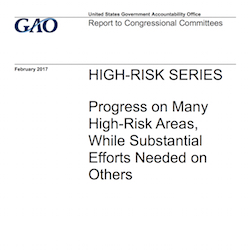
Medicare, Medicaid, medical product oversight and veterans’ healthcare are the four healthcare-related areas on the Government Accountability Office’s “2017 High Risk List,” released Wednesday.
The GAO compiles the list every two years at the start of a new Congress to call attention to agencies and program areas that it deems to be high risk due to their vulnerabilities to fraud, waste, abuse and mismanagement, or to those areas most in need of transformation. This year’s report spotlights 34 areas.
Medicare. The GAO said it designated Medicare as a high-risk program in 1990 because of its size, complexity and perceived susceptibility to mismanagement and improper payments. “Addressing Medicare’s short-term and long-term challenges is vitally important, not only for the millions of aged and disabled individuals who depend upon the program for healthcare coverage, but also for the families of these individuals who might otherwise bear the cost of their healthcare, the taxpayers who finance the program and the healthcare providers who depend upon receiving fair compensation for their services,” according to the office. “The aging of the population, coupled with the growth in per capita healthcare costs, will magnify these challenges over time. Therefore, continued close attention will be necessary to ensure that Medicare is sustainable for generations to come.”
Medicaid. The GAO designated Medicaid as a high-risk program in 2003, saying that its size, growth and diversity presented oversight challenges and that it was concerned about the adequacy of fiscal oversight. “Medicaid is one of the largest sources of funding for acute healthcare, long-term care and other services for low-income and medically needy populations,” according to the office. If measured by enrollment, Medicaid is the largest health program, and if measured by expenditures, it is second only to Medicare, the GAO said.
Medical products. The GAO added the oversight of medical products — “drugs, biologics and medical devices … used daily by Americans at home, in the hospital and in other healthcare settings” — to its high-risk list in 2009, maintaining that the FDA’s ability to protect the public health was challenged by rapid changes in science and technology, globalization, unpredictable public health crises, an increasing workload and the continuing need to monitor the safety of thousands of marketed medical products. “While progress has been made, we have found that some challenges remain and new ones, such as drug shortages, have emerged,” the GAO said.
VA healthcare. The GAO designated the Department of Veterans Affairs healthcare program as a high-risk area in 2015. “We continue to be concerned about VA’s ability to ensure its resources are being used cost-effectively and efficiently to improve veterans’ timely access to healthcare, and to ensure the quality and safety of that care,” the office said. The Veterans Health Administration is one of the largest healthcare delivery systems in the nation, according to the GAO, and demand for services is growing.



